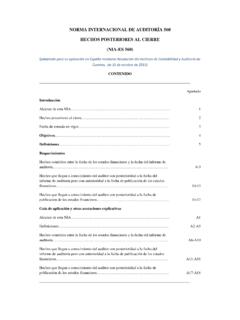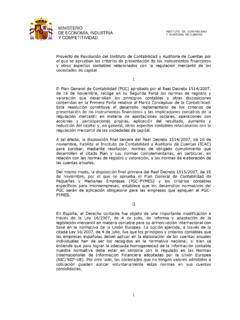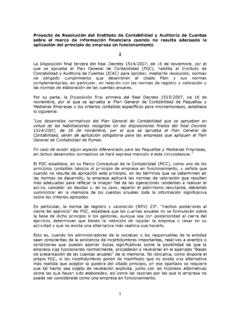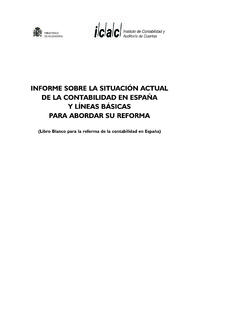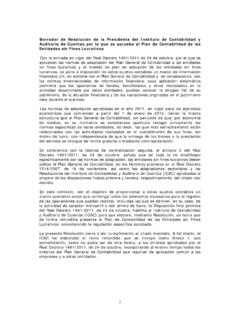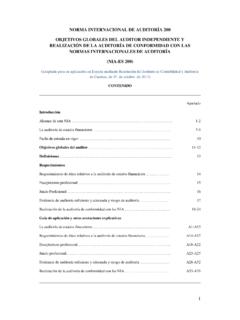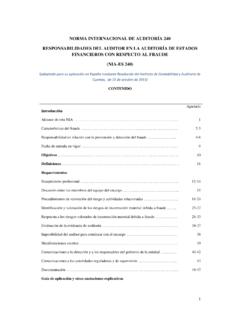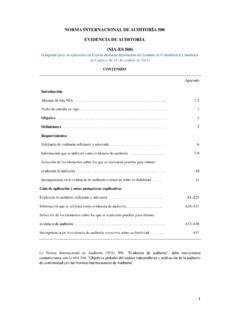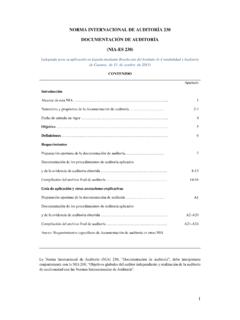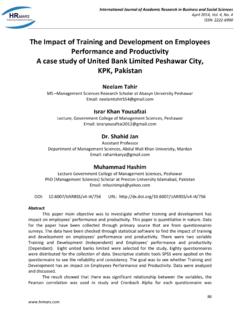Transcription of SPANISH GENERAL ACCOUNTING PLAN
1 1 SPANISH GENERAL ACCOUNTING PLAN 2 SPANISH GENERAL ACCOUNTING PLAN (PLAN GENERAL DE CONTABILIDAD ESPA OL ENGLISH TRANSLATION) 1. INTRODUCTION .. 6 2. ACCOUNTING FRAMEWORK .. 27 3. RECOGNITION AND MEASUREMENT STANDARDS .. 36 4. ANNUAL ACCOUNTS .. 98 5. STANDARD ANNUAL ACCOUNTS .. 113 6. ABREVIATED FORMAT FOR ANNUAL ACCOUNTS .. 161 7. CHART OF ACCOUNTS .. 179 8. DEFINITIONS AND ACCOUNTING ENTRIES .. 205 3 SPANISH GENERAL ACCOUNTING PLAN (PLAN GENERAL DE CONTABILIDAD ESPA OL ENGLISH TRANSLATION)1 1. INTRODUCTION 6 2. ACCOUNTING FRAMEWORK 27 1) Annual Accounts. Fair presentation 27 2) Disclosure requirements in annual accounts 27 3) ACCOUNTING principles 28 4) Components of the annual accounts 29 5) Recognition criteria for elements of annual accounts 30 6) Measurement criteria 31 7) Generally accepted ACCOUNTING principles 34 3.
2 RECOGNITION AND MEASUREMENT STANDARDS 36 1st Application of the ACCOUNTING Framework 36 2nd Property, plant and equipment 36 3rd Specific standards on property, plan and equipment 39 4th Investment property 40 5th Intangible assets 40 6th Specific standards on intangible assets 41 7th Non-current assets and disposal groups held for sale 42 8th Leases and similar transactions 44 9th Financial instruments 47 10th Inventories 65 11th Foreign currency 67 12th Value added tax (VAT), Canary Island tax (IGIC) and other 1 Approved by Royal Decree 1514/2007 of 16th November 2007 4 indirect taxes 69 13th Income tax 70 14th Revenue from sales and the rendering of services 74 15th Provisions and contingencies 76 16th Liabilities arising from long-term employee benefits 76 17th Share-based payment transactions 78 18th Grants, donations and bequests received 79 19th Business combinations 80 20th Joint ventures 92 21st Transactions between group companies 93 22nd Changes in ACCOUNTING criteria, errors and ACCOUNTING estimates 96 23rd Events after the balance sheet date 97 4.
3 ANNUAL ACCOUNTS 98 1st Document comprising the annual accounts 98 2nd Preparation of annual accounts 98 3rd Structure of the annual accounts 98 4th Abbreviated annual accounts 99 5th Standards commonly applicable to the balance sheet, the income statement, the statement of changes in equity and the statement of Cash Flows 100 6th Balance sheet 101 7th Income statement 104 8th Statement of change in equity 106 9th Statement of cash flows 107 10th Notes 109 11th Revenue for the period 110 12th Average number of employees 110 13th Group companies, jointly controlled entities and associates 110 14th Interim financial statements 111 15th Related parties 111 5 5. STANDARD ANNUAL ACCOUNTS 113 Standard format for annual accounts 113 Content of the notes to the annual accounts 123 6.
4 ABREVIATED FORMAT FOR ANNUAL ACCOUNTS 161 Abbreviated format for annual accounts 161 Content of the notes to the abbreviated annual accounts 167 7. CHART OF ACCOUNTS 179 8. DEFINITIONS AND ACCOUNTING ENTRIES 205 6 INTRODUCTION I With the approval of the GENERAL ACCOUNTING Plan through Decree 530/1973 of 22 February 1973, Spain embarked upon the modern-day trend of ACCOUNTING standardisation. Spain s subsequent entry into what is now the European Union entailed harmonising its ACCOUNTING standards with European Community ACCOUNTING legislation, hereinafter the ACCOUNTING Directives (Fourth Council Directive 78/660/EEC of 25 July 1978 related to the annual accounts of certain types of companies, and Seventh Council Directive 83/349/EEC of 13 June 1983 related to consolidated accounts).
5 Convergence was based on Law 19/1989 of 25 July 1989 and Royal Decree 1643/1990 of 20 December 1990, which approved the 1990 GENERAL ACCOUNTING Plan. As a result, true ACCOUNTING legislation was incorporated into SPANISH commercial law, giving financial information a distinctly international nature. The GENERAL ACCOUNTING Plan, as in other countries, was a key tool of standardisation. The standardisation process in Spain would not have been complete without the regulatory developments advocated by the ACCOUNTING and Auditing Institute (ICAC), with the collaboration of universities, professionals and other ACCOUNTING experts. These developments were based on the statements issued by national and international ACCOUNTING standards boards.
6 The SPANISH business community has without doubt helped to consolidate acceptance of ACCOUNTING standardisation by applying these new standards. In the year 2000, and with a view to making the financial information of European companies more consistent and comparable, irrespective of where these companies are domiciled or on which capital market they trade, the European Commission recommended to other European Community institutions that the consolidated annual accounts of listed companies be prepared applying the ACCOUNTING standards and interpretations issued by the International ACCOUNTING Standards Board (IASB). In order for ACCOUNTING standards drafted by a private organisation to constitute law in Europe, specific legislation had to be enacted.
7 European Parliament and Council Regulation 1606/2002 was introduced on 19 July 2002, defining the process for the European Union to adopt International ACCOUNTING Standards (hereinafter adopted IAS/IFRS). The Regulation made it mandatory to apply these standards in the preparation of consolidated annual accounts by listed companies, leaving member states to decide whether to allow or require direct application of the adopted IAS/IFRS to the individual annual accounts of all companies, including listed companies, and/or the consolidated annual accounts of other groups. 7 In Spain, the scope of the European decision was analysed by the Expert Committee created by the Ministry of Economy Order of 16 March 2001.
8 In 2002, the Committee prepared and published a report on the ACCOUNTING situation in Spain, setting out basic guidelines for reform. The main recommendation was that individual annual accounts should continue to be prepared under SPANISH ACCOUNTING standards, appropriately revised to harmonise the ACCOUNTING information and make it comparable, in keeping with the new European requirements. The Committee considered that the reporting company should decide whether to apply SPANISH ACCOUNTING standards or the European Community Regulation in the preparation of consolidated annual accounts. Based on these considerations, through the eleventh final provision of Law 62/2003 of 30 December 2003 on tax, administrative and social measures, the SPANISH legislator stipulated that the individual ACCOUNTING information of SPANISH companies, including listed companies, should continue to be prepared under the ACCOUNTING principles set out in SPANISH ACCOUNTING and commercial law.
9 The amendments proposed by the Expert Committee were enacted by Law 16/2007 of 4 July 2007, which revised and adapted commercial law to bring ACCOUNTING standards into line with European Union Regulations (hereinafter Law 16/2007). This law made amendments to the Commercial Code and the Companies Act, which were vital for the international convergence process while also ensuring that the modernisation of SPANISH ACCOUNTING practices did not contravene the legal regime governing aspects intrinsic to the operation of any trading company, such as the distribution of profit, obligatory share capital reductions and compulsory liquidation in the event of losses. The first final provision of Law 16/2007 authorised the government to approve the GENERAL ACCOUNTING Plan by Royal Decree, in order to set up a new legal regulatory framework compliant with European Community Directives considering the IAS/IFRS adopted under European Union Regulations.
10 In recognition of the importance of small and medium-sized enterprises (SMEs) in Spain, the law also empowered the government to supplement the GENERAL ACCOUNTING Plan with text adapted to the disclosure requirements of SMEs. Moreover, the Ministry of Economy and Finance was empowered to approve sector-specific adaptations proposed by the ACCOUNTING and Auditing Institute (ICAC), while the Institute itself may also approve standards to implement the GENERAL ACCOUNTING Plan and its complementary standards. With the procedure underway for approval of Law 16/2007 by the parliament, the ACCOUNTING and Auditing Institute started work on the new GENERAL ACCOUNTING Plan with the goal of drafting the text as swiftly as possible.
